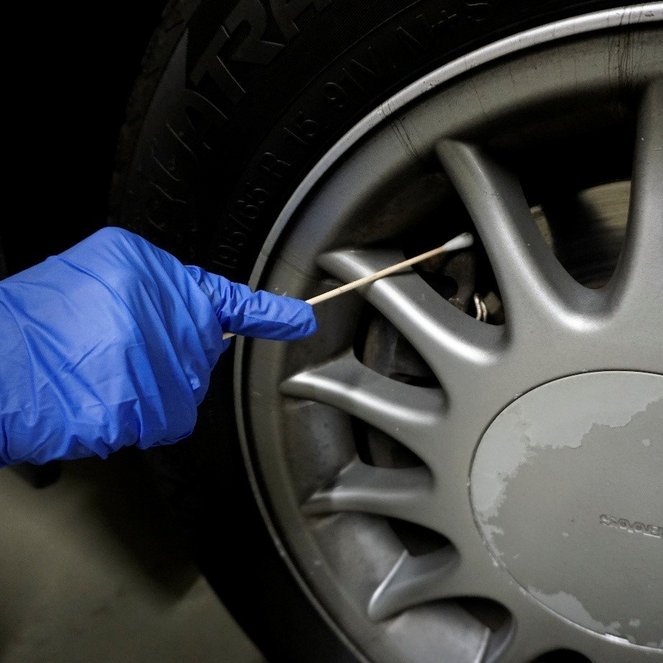Exploring Tire Additives in Surface Water

The protection of water resources requires effective measures to prevent impacts on ecosystems and human health. River sediments can play a key role…
Adjunct Professor, Department of Civil and Environmental Engineering,
Duke University, USA
Guest Professor, College of Environmental Science and Engineering,
Nankai University, China
☎ +43 1 4277 53320
✉ thilo.hofmann(at)univie.ac.at
⚲ Josef-Holaubek-Platz 2 (UZA II), Room 2C407, 1090 Vienna

Environmental contamination has become a planetary boundary that humanity is now crossing. Thilo Hofmann’s group explores how emerging contaminants behave in natural systems and seeks pathways towards more sustainable solutions. His research investigates the dynamics, fate, and transformations of both organic and inorganic pollutants, including plastics and nanoparticles, and develops strategies for their remediation. Current projects address “forever chemicals” such as PFAS, plastic pollution including tyre wear particles, plastic additives of concern, the impact of chemicals on the human microbiome, nanoparticles emissions from break-wear, and high-resolution mass spectrometry and transformation processes.
Thilo is also Co-Director of the University of Vienna’s Environment and Climate Research Hub, which brings together over 70 leading experts from the natural sciences, humanities, law, and economics to tackle today’s most pressing environmental challenges. He has received awards from the German Academic Scholarship Foundation, the Technical University of Berlin, and the German Chemical Society for Water Chemistry. He is Adjunct Professor at Duke University (USA) and Nankai University (China).




Plastic pollution poses a global challenge, even though plastics remain vital in sectors ranging from healthcare to agriculture. Our group studies plastic additives, tyre wear particles, and biodegradable plastics to understand how these materials behave once released into the environment. We examine the persistence and transformation of microplastics in industrial compost and agricultural soils, aiming to develop reliable extraction methods that can support future environmental standards. These studies provide essential insights into the life cycle of plastics and guide efforts to reduce their long-term accumulation.
Microbiome – Contaminant Interactions of Plastic Additives and Forever Chemicals: Chemical pollution can significantly impact microbial communities, with consequences for biodiversity, ecosystems, and human health. Our research examines the environmental fate of tire additives in natural and engineered aquatic systems through biodegradation experiments, investigating how microbiome composition influences degradation outcomes and, conversely, how chemical exposure alters microbial community structure. Furthermore, we study the effects of these contaminants, including tire additives and PFAS, as well as their mixtures, on human gut bacteria, assessing toxicity, bioaccumulation, and microbiome-level responses. This comprehensive approach aims to advance understanding of the cross-system impacts of chemical contaminants on both human and environmental microbiomes.
Heteroaggregation of Microplastics in Environmental Waters: After their release into natural waters and wastewater treatment systems, microplastics interact with naturally occurring particles and flocs. These interactions, known as heteroaggregation, can strongly influence how microplastics move and accumulate in the environment. Our research investigates the mechanisms and kinetics of these aggregation and adsorption processes under environmentally relevant conditions. Using laboratory simulations and advanced analytical techniques, we examine how particle size, surface chemistry, and water composition affect aggregation dynamics. This work provides essential insights into the physical and chemical behavior of microplastics and supports the development of more reliable models and mitigation strategies for managing plastic pollution in aquatic systems.
Tire Additives, Sorption and River Sediment Monitoring: Tire-derived additives are an emerging class of contaminants in surface waters, where they have the option to bind to fine particles and accumulate in riverbeds. Their partitioning and transformation processes are poorly constrained. Our research quantifies sorption to soils and sediments and monitors occurrence in river sediments across the Danube. We assess the influence of chemical structure and matrix properties that govern retention, mobility, and potential remobilisation. Through harmonised sampling, extraction, and targeted suspect screening, we are generating comparable datasets to find hotspots and track transformation products. These insights allow risk assessments and practical guidance for sustainable sediment management.
PFAS, a group of synthetic chemicals widely used in industrial applications, are known for their persistence, mobility, and toxicity. Their extensive use and resistance to degradation have made them ubiquitous environmental contaminants, posing serious risks to ecosystems and human health. Our research focuses on developing innovative and sustainable solutions for PFAS removal from water and soil. Key approaches include (i) activated biochars & biochar composites as advanced green sorbents, and (ii) modified zerovalent iron nanoparticles as cutting-edge reductants. Our work will provide critical insights to support the design of efficient remediation strategies for PFAS-contaminated sites, contributing to long-term environmental protection.

As vehicle exhaust emissions decline through cleaner technologies, non-exhaust sources, including brake wear, tire abrasion, and road dust, dominate urban particulate pollution. Despite their growing significance, the formation, composition, and environmental fate of these particles remain poorly understood. Brake wear particles are particularly complex pollutants, combining micro- and nanoplastic properties with high metal content. Our group applies single-particle ICP-TOFMS analysis to track individual metal-bearing particles across environmental compartments. This multi-element single-particle approach enables detection and characterisation at low concentrations in complex samples, revealing source-specific chemical fingerprints that traditional bulk methods cannot resolve. We investigate transformation mechanisms of non-exhaust particles and their behaviour at environmental interfaces. This research advances understanding of urban particle chemistry and develops analytical tools for characterising emerging particulate pollutants in air, soil, and water systems.

Transformation and Simulation Many environmental pollutants change once released into nature, forming new compounds with unknown properties. To understand these transformations, our group replicates environmental processes in the laboratory using advanced instrumental systems combined with liquid chromatography and mass spectrometry. We simulate hydrolytic, photolytic, and enzymatic redox reactions to generate reference data that help identify transformation products in real-world samples. By scaling up selected synthesis routes, we also produce authentic reference materials that allow for accurate quantification. This work supports risk assessment and helps predict how contaminants evolve and persist in the environment.
Environmental Suspect Screening and Non-Target Analysis: Environmental samples are complex mixtures containing thousands of natural and synthetic chemicals. To detect and identify contaminants of concern, we use cutting-edge liquid chromatography–high-resolution mass spectrometry. Our research combines two complementary strategies: suspect screening, which searches for known compounds, and non-target analysis, which reveals unexpected or previously unrecognised contaminants through data-driven approaches such as molecular networking. We focus on improving the annotation and semi-quantification of transformation products. By advancing these analytical tools, we uncover hidden chemical risks and help shape more effective environmental monitoring and regulation.

Biopesticides are emerging as promising, more sustainable alternatives to conventional pesticides, partly because they are expected to degrade naturally in soil and water. Yet, how fast and through which pathways they transform remains largely unknown.
Our research examines the biodegradation and biotransformation of selected biopesticides, focusing on how their chemical structure affects their environmental persistence. These insights not only expand our scientific understanding but also support the development of safer, environmentally friendly crop protection products that align with sustainable agricultural goals.


The protection of water resources requires effective measures to prevent impacts on ecosystems and human health. River sediments can play a key role…

Per- and polyfluoroalkyl substances (PFAS) are a group of manufactured chemicals that have garnered significant attention due to their widespread…

The University of Vienna and BASF have started a research collaboration to better understand the behavior of biodegradable plastics in compost. This…
Thilo Hofmann regards science communication as an essential component of scholarly practice. In his capacity as Co-Director of the Environment and Climate Research Hub (ECH) at the University of Vienna, he prioritises the dissemination of complex environmental research to diverse societal audiences. Under his direction, the ECH has established initiatives such as the international and interdisciplinary open online course 'Environmental Emergencies – Navigating Climate Change, Biodiversity Loss and Environmental Pollution' (iMOOX), the public lecture series 'Environment, Climate, Sustainability: From Knowledge to Action', and the series of events, 'Environmental Dialogue' ("Umwelt im Gespräch"), which address current environmental and climate issues and encourage discussion from different perspectives in a public-facing format. Furthermore, Hofmann is a frequent presenter at policy institutions and professional organisations, addressing a range of topics including sustainable food systems, resource use and climate change, thereby connecting rigorous research with pressing global challenges.
Lotteraner L, Möller T, Hofmann T. The Importance of Being Thorough: How Data Analysis Choices Impact the Perceived Relationship between Pollutants and Predictors. Water Research. 2026 Jan 1;288:124639. doi: 10.1016/j.watres.2025.124639
Kintzi A, Göldner V, Daturpalli S, Battagliarin G, Künkel A, Hofmann T et al. Combining respirometry and HPLC-HRMS to elucidate the biodegradation of polyethylene glycol and its derivatives. Polymer Degradation and Stability. 2025 Sept 1;242:111639. doi: 10.1016/j.polymdegradstab.2025.111639
Sherman A, Hämmerle LE, Mordechay EB, Chefetz B, Hofmann T. Uptake of tire-wear derived compounds by lettuce grown in three soils. Environment International. 2025 Sept;203:109742. doi: 10.1016/j.envint.2025.109742
Henkel C, Hüffer T, Maletić S, Hofmann T. Micro- and nanoplastics as transport vectors for organic contaminants in the environment: A critical review. Current Opinion in Colloid and Interface Science. 2025 Aug;78(101934). doi: 10.1016/j.cocis.2025.101934
Xu S, Zhu M, Fan L, Yao Y, Cao T, Ji R et al. Eco-Corona Formation Enhances Cotransport of Nanoplastics and Organic Contaminants in Porous Media. Environmental Science and Technology. 2025 Jun 16;59(25):12978-12989. doi: 10.1021/acs.est.5c02378
Thilo Hofmann is part of the FWF-funded Cluster of Excellence (CoE)

